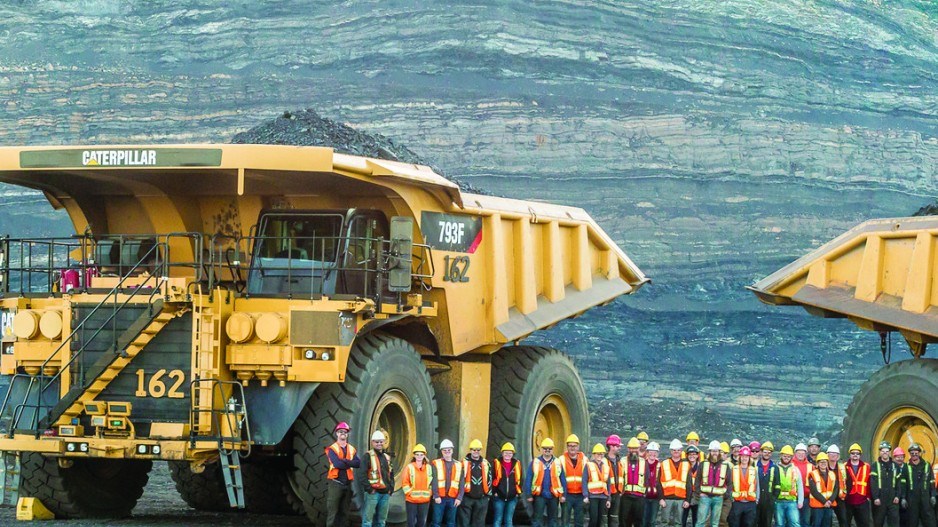As of May this year, an estimated 4,385 workers were employed on the $8.8 billion Site C dam construction project near Fort St. John.
Kitimat and Terrace are humming with activity, thanks to the $40 billion LNG Canada-Coastal GasLink pipeline project.
Port expansion in Prince Rupert has created an additional 1,000 jobs since 2016.
Employment is strong in the Dawson Creek-Tumbler Ridge-Chetwynd triangle, thanks in part to Conuma Coal Resources reopening a third mine – Willow Creek – last year.
And in the Golden Triangle of northwest B.C., mining exploration spending was up by about $165 million in 2018, according to EY.
Economic growth in B.C.’s north is reflected in housing starts and construction permits. Residential building permits in northern B.C. were up 30% in 2018 compared with the total in 2017, industrial permits were up 427% and institutional and government building permits were up 42%, according to the annual State of the North report.
Overall, indicators show northern B.C.’s economy growing in 2018. But in small, forestry-dependent communities like Mackenzie and Fort St. James, it’s a very different story. Both have been hit hard recently with sawmill closures and curtailments.
“You go to Kitimat and Terrace right now, things are hopping,” said Joel McKay, CEO of the Northern Development Initiative Trust, which publishes the State of the North report.
“In Prince Rupert, where you’ve got the Port of Prince Rupert – you know, hundreds of new jobs created in a couple of years with their expansion – lots of activity there. So no question about it, some of those major industrial projects are really helping to keep some communities afloat.
“If you pop up north to Mackenzie, Fort St. James, Vanderhoof, Fraser Lake and then down Highway 97 into the Cariboo, that’s where you start to see the impacts of the downturn in forestry. And that is a different story.
“Those communities are concerned about the residents they’re going to lose, their future tax base in order to deliver services.”
Whether it is fisheries, forestry, mining or oil and gas, resource industries are cyclical, so many northern communities will always be vulnerable to boom-and-bust cycles.
But the recent downturn in forestry has been particularly severe.
In Mackenzie, some 600 sawmill workers, loggers and truck drivers are suddenly out of work, thanks to the permanent closure of a Canfor Corp. (TSX:CFP) sawmill and extended curtailment at a Conifex Timber Inc. (TSX:CFF) mill.
In Fort St. James, 170 sawmill workers were laid off when Conifex closed its sawmill there. Conifex hopes to sell the mill to Hampton Lumber.
B.C.’s timber supply is in a long-term decline, thanks to the mountain pine beetle infestation and forest fires, which have taken more than 50% of the merchantable timber out of the annual allowable cut.
High lumber prices in the U.S. forestalled the inevitable mill closures. But when prices started to fall, the sawmill closures and curtailments came quickly and have left communities like Mackenzie and Fort St. James reeling.
“It comes as zero surprise to anybody who’s been watching forestry for a while that there was going to be a downturn and it was going to be big,” McKay said. “What happened this year was it all kind of came at once.”
In mid-August, close to 1,000 people staged a rally in Mackenzie to call public attention to the sweeping job losses. They are pressuring the provincial government to do something, which in turn is pressuring the federal government to do something.
Doug Donaldson, minister of forests, lands, natural resource operations and rural development, has written to the federal government asking for federal aid for workers.
In Mackenzie, about one-third of the laid-off workers are 55 years old or older, so the province is asking the federal government to provide early retirement incentives.
“Some of those workers are seeking early retirement, but they have some years to go before their pensions kick in,” Donaldson said. “So that’s the bridging funding we’re seeking from the federal government.”
The government is also asking Ottawa to lower eligibility requirements for employment insurance.
With thousands of workers needed for multibillion-dollar projects like the Coastal GasLink pipeline, there may be opportunities for laid-off sawmill workers to get jobs elsewhere in northern B.C.
The Coastal GasLink pipeline alone, which will run from Dawson Creek to Kitimat, is expected to employ 2,000 to 2,500 workers over a four-year period.
“It’s absolutely true that between Site C, Trans Mountain, Coastal GasLink, LNG Canada and some of the other projects that might come along, those create employment opportunities for the workers who may be impacted by the closures or curtailments,” McKay said. “But the challenge is, not in 100% of cases are skill sets going to be transferable.”
And while some laid-off loggers and sawmill workers may get jobs elsewhere, those jobs may require them to move, which exacerbates the drain on small communities like Mackenzie, which loses both industrial and residential taxpayers.
Some northern communities – Quesnel, for example – have been anticipating the long-term decline in forestry and have been working to diversify their economies to insulate them from the swings that characterize resource sectors. Tourism is one area Quesnel has focused on.




